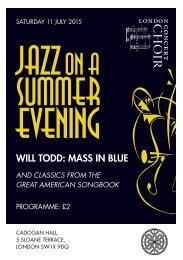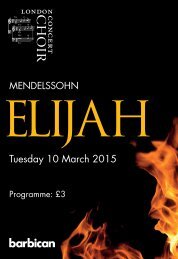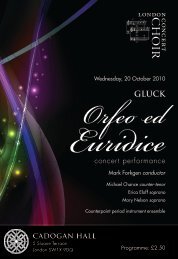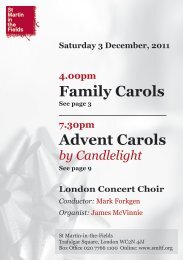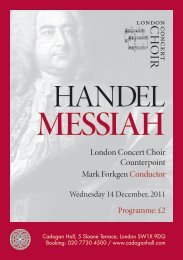11 November, 2015: Mozart Requiem
- No tags were found...
You also want an ePaper? Increase the reach of your titles
YUMPU automatically turns print PDFs into web optimized ePapers that Google loves.
King of Bohemia on 6th September in Prague. <strong>Mozart</strong> wrote La clemenza di Tito<br />
in the shortest of times, partly on the coach to Prague where he stayed for the<br />
two weeks running up to the premiere. On his return from what must have been<br />
an exhausting journey he continued work on The Magic Flute in preparation<br />
for its premiere. It was probably not until October that he started work on the<br />
<strong>Requiem</strong>. He was simultaneously finishing the Clarinet Concerto (K622) for his<br />
friend Anton Stadler, which was premiered on 16th October, and composing<br />
a masonic cantata (K623, the last work he catalogued in his own register of<br />
works) that he conducted on 18th <strong>November</strong> 1791.<br />
At the heart of <strong>Mozart</strong>’s <strong>Requiem</strong> is the four-part vocal writing. Whether in a<br />
homophonic texture as in the Dies irae and Rex tremendae, a contrapuntal<br />
structure as in the <strong>Requiem</strong> aeternam, or in a fugue such as the Kyrie and the<br />
‘Quam olim Abrahae’ section, <strong>Mozart</strong>’s Mass for the Dead speaks mainly through<br />
the human voice.<br />
The composer was well-acquainted with the great traditions of choral writing<br />
established by Bach and Handel. The influence of Handel can be heard not only<br />
in some melodic lines, but also in <strong>Mozart</strong>’s highly accomplished fugal writing<br />
where lyrical, chamber music-like passages such as the quartet in the Recordare<br />
are followed by great dramatic outbursts in the choral fugues. On the surface,<br />
the music is driven by the same impetus that characterizes Handel’s<br />
choral works; yet the underlying sadness, particularly in the woodwind, lends<br />
a different quality to <strong>Mozart</strong>’s music.<br />
As in the symphony heard earlier, <strong>Mozart</strong> modifies the orchestral sound<br />
to suit his intentions: by excluding higher-pitched instruments such as<br />
flutes and oboes from the orchestral line-up he achieves a different colour,<br />
avoiding anything harsh or overly bright. The ensemble of basset-horns,<br />
bassoons, trumpets, trombones, timpani and strings makes for a dark sound<br />
which intensifies the sombre mood of the <strong>Requiem</strong> Mass. This is particularly<br />
expressive in the Introitus where the extraordinarily beautiful opening





